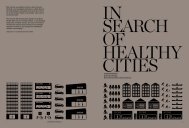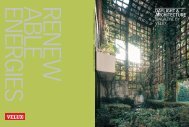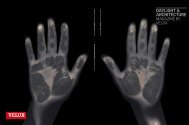Download as PDF - Daylight & Architecture - Magazine by | VELUX
Download as PDF - Daylight & Architecture - Magazine by | VELUX
Download as PDF - Daylight & Architecture - Magazine by | VELUX
Create successful ePaper yourself
Turn your PDF publications into a flip-book with our unique Google optimized e-Paper software.
The Experienceof <strong>Daylight</strong>Views towards the outside are <strong>as</strong>ignificant quality criterion forarchitectural spaces – and notonly in office buildings.A considerable body of research shows that people prefer daylit spacesto those lacking natural light. Why should this be? If there is sufficientlight to see, why would people prefer one source to another? To answerthis question, we need to understand the evolved relationship betweenhumans and natural light.By Judith HeerwagenPhotography <strong>by</strong> Gerry JohanssonImagine you are on a camping trip thatl<strong>as</strong>ts a lifetime. You and your small bandof hunter-gatherers wake up with the firstlight of day. You huddle around the fadingembers of the camp fire, eat leftovers fromthe night before and discuss the day’sforaging activities. By the time the sun isfully up, you head into the bush using thebright light of day to identify edible fruitsand berries and to track animals. By noon,the sun is hot and you seek the shade ofa tree canopy for refuge and rest. As yousnack on nuts and berries, conversationis drawn to the horizon where large stormclouds have begun to gather. You’re a longway from camp and are concerned aboutgetting back. Dark clouds gather, cuttingout the sun overhead but providing dramaticshafts of light in the distance. Itrains hard, but briefly, <strong>as</strong> you huddle undera rock outcropping for protection. Asyou head back, the clouds begin to breakand a rainbow lights up the sky signallingthe end of the storm. You get back to campjust in time for dinner. You discuss theday’s events around the campfire <strong>as</strong> thesun begins to set, lighting the sky orangeand pink. Dusk brings with it a greynessthat hides the details of the landscape,making it more difficult to discern whatis happening beyond the campsite. Soonit is dark and everyone gathers around thefire for warmth, light and companionshipbefore going to sleep under the soft lightof the moon.<strong>Daylight</strong> from anevolutionary perspectivePrior to the advent of buildings, humanslived immersed in nature. Daily activitieswere aided or constrained <strong>by</strong> the presenceor absence of daylight and <strong>by</strong> qualities oflight that signalled time and weather. Ourphysiological systems – especially oursleep-wake cycles – were in synch with thediurnal rhythms of daylight, <strong>as</strong> were ouremotional responses to light and darkness.The strong, consistent preference for daylightin our built-up environments todaysuggests that evolutionary pressures arelikely to be influencing our responses.Although all our sensory systems actingtogether were important to survival,the visual system is our primary mode ofgathering information. Thus, light musthave played a powerful role in informationprocessing and survival. In ancestralhabitats, light w<strong>as</strong> likely to have had severalkey functions that are relevant to thedesign and operation of built-up environments.These include:• Indicator of time. Natural light changessignificantly over the course of the day,providing a signal of time that h<strong>as</strong> beencrucial to survival throughout humanhistory. Being in a safe place when thesun w<strong>as</strong> setting w<strong>as</strong> not a trivial matterfor our ancestors, and it is still importantto human well-being.• Indicator of weather. Light also changeswith weather, from the dark, ominouscolour of storms to rainbows andbeams of light <strong>as</strong> clouds break up andrecede. Attending to the variability inlight and its relationship to changes inweather would have been highly adaptive(Orians and Heerwagen, 1992).• Signal of prospect and refuge. Thesense of prospect is signalled <strong>by</strong> distantbrightness and refuge is signalled <strong>by</strong>shadow (Appleton, 1975, Hildebrand,1999). Brightness in the distance aids<strong>as</strong>sessment and planning because it allowsfor information to be perceived insufficient time for action to be taken.High prospect environments includeopen views to the horizon and a luminoussky (‘big sky’). A sense of refugeis provided <strong>by</strong> shadows from tree canopies,cliff overhangs, or other naturalforms. Mottram (2002) suggests thatallowing the eyes to rest on infinity(which the horizon represents visually)may be beneficial, even if the viewis perceptually manipulated throughvisual images rather than actual distantviews. Thus, our natural attractionto the horizon could be satisfied inmany ways through the manipulationof light and imagery applied to verticalsurfaces.• Signal of safety, warmth, and comfort.Although we usually think of the sun<strong>as</strong> the primary source of light in thenatural environment, fire also served<strong>as</strong> a source of light and comfort, bothphysical and psychological. Anthropologistand physician Melvin Kon-15










